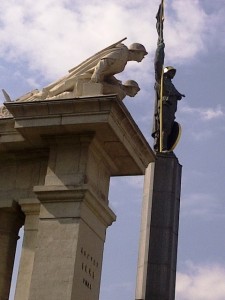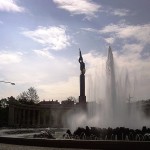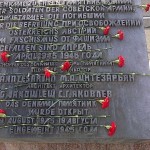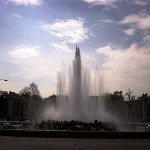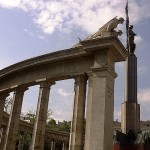Operation Radetzky – the 70th Anniversary of Vienna’s Fight to Survive
“The majority of common people loathe war and pray for peace; only a handful of individuals whose evil joys depend on general misery, desire war.” — Desiderius Erasmus
 Today in Vienna, like in many parts of the world, a visitor steals into town in the middle of the night to leave surprises for all the good boys and girls. Austrian tradition demands that children prepare nests for the Easter bunny so that the big old rabbit knows just where to leave the chocolate, colored eggs and goodies. The tradition – like many traditions – is also perhaps rooted in a practical benefit — nests cut down on the risk that any errant egg is left forgotten until odorous hints demand that the suffering family uncover its whereabouts weeks later.
Today in Vienna, like in many parts of the world, a visitor steals into town in the middle of the night to leave surprises for all the good boys and girls. Austrian tradition demands that children prepare nests for the Easter bunny so that the big old rabbit knows just where to leave the chocolate, colored eggs and goodies. The tradition – like many traditions – is also perhaps rooted in a practical benefit — nests cut down on the risk that any errant egg is left forgotten until odorous hints demand that the suffering family uncover its whereabouts weeks later.
Seventy years ago, on April 6, 1945, however, the visitors who swept into Vienna were coming for very different reasons. And the preparations that Hitler demanded of the city of Vienna included no Easter nests.
On March 19, 1945, Hitler, drafted the ARLZ measures (Auflösung (some sources Auflockerung (breaking up)) – , Räumung, Lähmung, Zerstörung – Liquidation, Stripping, Paralysis, Destruction). Historians later called the plan to destroy all infrastructure of the German Reich before the Allied Troops could invade the Nero Decree – in reference to the crazed Roman Emperor who is said to have sang in stage costume (“played the fiddle”) while his city went up in flames. In Vienna, German troops should destroy all of the city’s vital infrastructure for traffic, information, industry and public utilities. This would include bridges, railway stations, water plants, electrical plants, gas plants, important road corridors, public transportation networks – in short anything and everything the enemy could use to help them advance their goals. The only thing wrong with the plan (though not according to Hitler who was no doubt upset about the obvious downfall of his “superior race” and not adverse to putting a little punishment into the mix) was that such destruction would render the facilities not only useless for the enemy but for the Viennese civilians as well. Wisely realizing that his plan might not be his most popular measure, Hitler kept his ARLZ measures secret from the general public but even in the pre-internet days of WWII, rumors had wings.
The Viennese major, Carl Szokoll, was instructed to draft the plans for Vienna’s self-destruction — so thorough and devious, that it even included the Anker bread factory (!) But Major Carl Szokoll was not just another major. In fact, almost two years before he was involved in a bit of a German Reich scandal. As an army captain in Vienna, he had helped his commander, Colonel Heinrich Kodre, round up all the leading members of the SS and Nazi administration in the city as part of the 20 July plot to assassinate Hitler and take control. The plot failed and while Stauffenberg and his crew were executed and Colonel Kodre deported to a concentration camp, Szokoll managed to talk his way out of serious repercussions (death by execution) by convincing the Gestapo that he had simply been following orders (which very fortunate for Szokoll, the Nazis obviously found to be a legitimate excuse). But by 1945, upon receipt of the ARLZ measures, Szokoll was once again willing to risk his life to counter his Nazi superiors.
In Spring 1945, Major Szokoll joined “Operation Radetzky” –named after the beloved Austrian general, “Father Radetzky” who Strauss immortalized in his song the “Radetzky March” (played annually at the Vienna Philharmonic New Year’s concert to the clapping and enthusiasm of all Viennese).
“Operation Radetzky” intended to save Vienna from the bleak fate of Berlin, Budapest and Warsaw by making it an “open city” – meaning a place that does not put up any resistance to incoming foreign troops. Operation Radetzky’s success depended on the cooperation of commanders in Vienna who should pretend to be preparing to destroy the city while making plans to save it. Szokoll and his supporters also joined forces with the resistance fighters of the city (O5 and POEN). Szokoll’s Staff Sergeant, Käs, sucessfully managed to make contact with the Soviet Red Army, offer cooperation and request that Vienna be spared annihilation. Plans were made to withdraw the city’s defense units as soon as the Soviet Army closed in and assist the Red Army in taking over the city once they arrived. Meanwhile, the Allied troops would cease their bombing of the city, preserve access to the water supply and refrain from destroying key installations.
On April 5, Soviet planes released the agreed upon red flares to signal their coming entry into the city. The resistance fighters responded with green flares to mark the beginning of Operation Radetzky. While the Red Army advanced to the city, the resistance fighters within Vienna were to wrest control from the SS and Nazi administration in order to peacefully hand over the city to the Soviets on April 6 at 12:30 pm (don’t ask me why at 12:30 not noon, I have no idea). However, on April 5, the Nazis became privy to the plan, rounded up three of Szokoll’s co-conspirators (Major Karl Biedermann, Lieutenant Rudolf Raschke, and Second Lieutenant Alfred Huth) and publicly hanged them from lampposts at Floridsdorf Spitz on April 8. Signs attached to their bodies read: “I have made a pact with the Bolsheviks.” Szokoll, however, was not in Vienna at the time of the arrests and was therefore able to evade capture.
Despite the blow, the Radetzky units managed to share vital information with the Red Army concerning the troop, weapon and bomb locations of the Nazis in Vienna. In addition, the Resistance advised the Red Army to advance from the west and north and finally invade via the Vienna Woods in the East rather than enter from the south where Nazi troops expected them.
On April 6 the assault on Vienna began and ended only 8 days later on April 13. The swift capture of Vienna meant that Nazi troops had no time to implement the ARLZ measures, sparing the city the devastation its neighbors to the east had suffered (in Berlin, SS troops put up a serious fight causing severe casualties and damage – some estimate that over 200,000 died during the siege). As Soviet troops advanced into the inner districts, Viennese helped them navigate through the streets. White flags and sheets were hung from the windows and civilians helped German soldiers lay down their weapons by giving them a quick change of clothes to replace their Reich uniforms. Historians estimate that about 37,000 soldiers and 3000 civilians lost their lives in the battle for Vienna – casualties far fewer than other cities. Though, every third house was destroyed or damaged, things could have been far worse. In Budapest, the siege had lasted 50 days, 80 percent of the buildings had been destroyed and hundreds of thousands of people died with an estimated 25,000 dying of starvation.
During the war 90,000 Viennese men died as soldiers and 60,000 Viennese Jews were murdered. Stephansdom, the Riesenrad, Parliament, the Burgtheater and the City Operahouse all suffered fire or severe damage.
And yet.
On April 30, the cast of the Burgtheater was already putting on a show and on May 1, the Vienna Philharmonic played its first after-war concert.
But the battle was far from over. While the Soviets maneuvered to install a pro-Communist postwar government in Vienna, the British and Americans had other plans for the city and the Austrians anchored the Declaration of Neutrality in 1955 in their Constitution of Austria declaring itself “permanently neutral.”
READ MORE HERE
Frankfurter Rundschau, 13. April 2005, „Schlacht um Wien brachte Tod und Zerstörung“ by Christian Fürst
The Guardian, 30 August 2004, Carl Szokoll Obituary
New Perspectives on Austrians and World War II, edited by Gunter Bischof, Fritz Plasser, Barbara Stelzl-Marx
The Setting of the Pearl, Vienna under Hitler, Thomas Weyr
Anything from Manfried Rauchensteiner – Austrian Historian, military expert, President of the Austrian Commission for Military History and a former professor of mine. Maybe start out with his book on WWII
